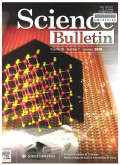- 钛学术文献服务平台 \
- 学术期刊 \
- 基础科学期刊 \
- 自然科学总论期刊 \
- 科学通报(英文版)期刊 \
null
Magnetic properties of street dust and topsoil in Beijing and its environmental implications
基本信息来源于合作网站,原文需代理用户跳转至来源网站获取
摘要:
Environmental magnetic measurements were carried out on the samples of street dust and topsoil, which were collected along the roadway in the urban and suburb of Beijing, including magnetic sus-ceptibility (χ), anhysteretic remanent magnetization (ARM), isothermal remanent magnetization (IRM) of all samples and temperature-dependence of magnetic susceptibilities and magnetic hysteresis pa-rameters of representative samples. Obvious differences exist between the samples of street dust and those of topsoil. Compared with topsoil samples, the concentration of magnetic particles and high-coercivity components in street dust samples are higher, and the magnetic grains are coarser. Both dust and topsoil samples are dominated by ferrimagnetic minerals, and iron particles are only detected in some dust samples. These results suggest that street dust samples reflect the characteris-tic of particles produced by industrial and traffic activities, and the magnetic property of topsoil sam-ples represents the characteristic of particles from both anthropogenic and natural sources. The dis-tribution of magnetic parameters is influenced by the environment where the samples are collected, like industry, traffic density and other rOad conditions. Hard isothermal remanent magnetization (HIRM) may be used as an indicator of particles produced by traffic activity. Dust storm samples collected on 17 and 18 April, 2006 have different magnetic properties from street dust and natural particles, like loess and paleosol, which indicate that the dust storm might be mixed with anthropogenic particulates during transport and falling.

推荐文章
期刊_丙丁烷TDLAS测量系统的吸收峰自动检测
带间级联激光器
调谐半导体激光吸收光谱
雾剂检漏 中红外吸收峰 洛伦兹光谱线型
不同盐度、温度及光照对漂浮浒苔生理生态的影响
浒苔
盐度
温度
光照
生理生态
期刊_联合空间信息的改进低秩稀疏矩阵分解的高光谱异常目标检测
高光谱图像
异常目标检测 低秩稀疏矩阵分解 稀疏矩阵 残差矩阵
内容分析
关键词云
关键词热度
相关文献总数
(/次)
(/年)
引文网络
引文网络
二级参考文献 (133)
共引文献 (202)
参考文献 (38)
节点文献
引证文献 (0)
同被引文献 (0)
二级引证文献 (0)
1975(1)
- 参考文献(0)
- 二级参考文献(1)
1977(5)
- 参考文献(1)
- 二级参考文献(4)
1980(1)
- 参考文献(1)
- 二级参考文献(0)
1981(2)
- 参考文献(0)
- 二级参考文献(2)
1982(3)
- 参考文献(1)
- 二级参考文献(2)
1983(1)
- 参考文献(0)
- 二级参考文献(1)
1984(3)
- 参考文献(1)
- 二级参考文献(2)
1985(2)
- 参考文献(0)
- 二级参考文献(2)
1986(1)
- 参考文献(1)
- 二级参考文献(0)
1988(3)
- 参考文献(1)
- 二级参考文献(2)
1990(4)
- 参考文献(0)
- 二级参考文献(4)
1991(2)
- 参考文献(1)
- 二级参考文献(1)
1992(7)
- 参考文献(1)
- 二级参考文献(6)
1993(3)
- 参考文献(1)
- 二级参考文献(2)
1994(6)
- 参考文献(0)
- 二级参考文献(6)
1995(10)
- 参考文献(1)
- 二级参考文献(9)
1996(8)
- 参考文献(1)
- 二级参考文献(7)
1997(5)
- 参考文献(0)
- 二级参考文献(5)
1998(10)
- 参考文献(2)
- 二级参考文献(8)
1999(21)
- 参考文献(3)
- 二级参考文献(18)
2000(14)
- 参考文献(0)
- 二级参考文献(14)
2001(13)
- 参考文献(3)
- 二级参考文献(10)
2002(8)
- 参考文献(3)
- 二级参考文献(5)
2003(18)
- 参考文献(3)
- 二级参考文献(15)
2004(15)
- 参考文献(9)
- 二级参考文献(6)
2005(3)
- 参考文献(2)
- 二级参考文献(1)
2006(2)
- 参考文献(2)
- 二级参考文献(0)
2008(0)
- 参考文献(0)
- 二级参考文献(0)
- 引证文献(0)
- 二级引证文献(0)
引文网络交叉学科
相关学者/机构
期刊影响力
科学通报(英文版)
主办单位:
中国科学院
出版周期:
半月刊
ISSN:
1001-6538
CN:
11-1785/N
开本:
大16开
出版地:
北京东黄城根北街16号
邮发代号:
2-177
创刊时间:
1950
语种:
eng
出版文献量(篇)
9507
总下载数(次)
1
期刊文献
相关文献
推荐文献
- 期刊分类
- 期刊(年)
- 期刊(期)
- 期刊推荐
力学
化学
地球物理学
地质学
基础科学综合
大学学报
天文学
天文学、地球科学
数学
气象学
海洋学
物理学
生物学
生物科学
自然地理学和测绘学
自然科学总论
自然科学理论与方法
资源科学
非线性科学与系统科学
科学通报(英文版)2022
科学通报(英文版)2021
科学通报(英文版)2020
科学通报(英文版)2019
科学通报(英文版)2018
科学通报(英文版)2017
科学通报(英文版)2016
科学通报(英文版)2015
科学通报(英文版)2013
科学通报(英文版)2012
科学通报(英文版)2011
科学通报(英文版)2010
科学通报(英文版)2009
科学通报(英文版)2008
科学通报(英文版)2007
科学通报(英文版)2006
科学通报(英文版)2005
科学通报(英文版)2004
科学通报(英文版)2003
科学通报(英文版)2002
科学通报(英文版)2001
科学通报(英文版)2000
科学通报(英文版)2008年第9期
科学通报(英文版)2008年第8期
科学通报(英文版)2008年第7期
科学通报(英文版)2008年第6期
科学通报(英文版)2008年第5期
科学通报(英文版)2008年第4期
科学通报(英文版)2008年第3期
科学通报(英文版)2008年第24期
科学通报(英文版)2008年第23期
科学通报(英文版)2008年第22期
科学通报(英文版)2008年第21期
科学通报(英文版)2008年第20期
科学通报(英文版)2008年第19期
科学通报(英文版)2008年第18期
科学通报(英文版)2008年第17期
科学通报(英文版)2008年第16期
科学通报(英文版)2008年第15期
科学通报(英文版)2008年第14期
科学通报(英文版)2008年第13期
科学通报(英文版)2008年第12期
科学通报(英文版)2008年第11期
科学通报(英文版)2008年第10期

 免费查重
免费查重










